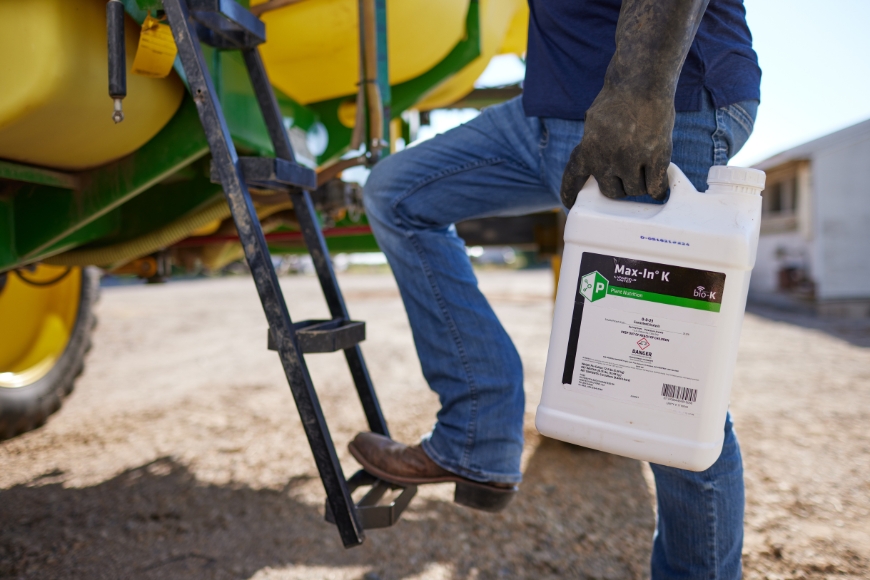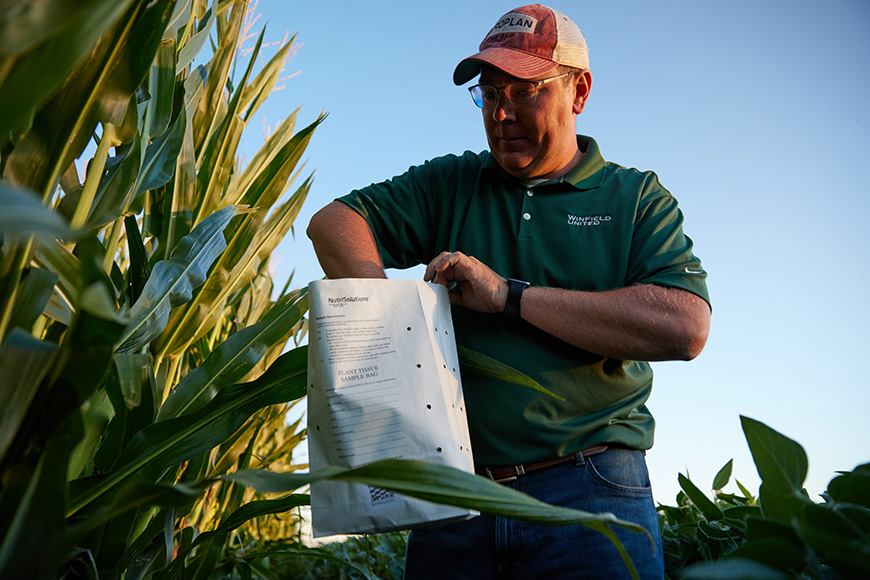How to Mitigate In-Season Nutrient Deficiencies

When it comes to maximizing yield potential in corn and soybeans, few things are more important than maintaining proper nutrient balance throughout the growing season. Even with a solid pre-season fertility plan, environmental factors, crop stress and soil conditions can lead to in-season nutrient deficiencies that may limit yield potential. Fortunately, there are diagnostic tools to help you identify deficiencies in-season, and with timely action, you may be able to mitigate them.
In corn, I recommend starting tissue sampling at the V4–V5 growth stage and continuing every two weeks in intensively managed fields to track trends. Starting early allows you more flexibility to include foliar nutrients with planned herbicide and fungicide passes.
For soybeans, begin sampling at V3–V4 to gauge nutrient status. Pulling another sample at R1–R2 before a planned fungicide pass provides an opportunity to supplement nutrients ahead of pod fill, if necessary.
The WinField® United NutriSolutions® App provides timely data to help you and your retailer understand what nutrients may be responsive or deficient and how to respond. Fueled by insights gathered from tissue and soil samples, the app helps you analyze the in-season health of your fields so you can adjust crop nutrition for maximum return potential on every investment and acre.
If you can’t conduct tissue sampling, visual scouting can also help identify a nutrient deficiency—but it’s not always straightforward. Many deficiencies have similar visual symptoms, making it hard to diagnose accurately without a tissue analysis. Visual signs can serve as a red flag, indicating the need for deeper investigation.
Corn, for example, tends to be highly responsive to or deficient in zinc, boron, manganese and nitrogen. Some corn samples may also be responsive to or deficient in magnesium and sulfur.
Soybeans are more often deficient or responsive to manganese and potassium.
In my experience, even with solid pre-season applications, many fields fall short on critical nutrients in-season. Nutrient deficiencies aren’t always about insufficient fertilizer. Environmental and soil conditions can limit nutrient availability, including:
• Compaction or insect damage that inhibits root growth
• High or low soil pH (ideal pH is around 6.5)
• Nutrient imbalance (an excess of one nutrient can tie up another)
• Low organic matter or overall fertility degradation
• Cool soil temperatures, which can slow nutrient uptake
Addressing these foundational issues helps reduce the risk of in-season nutrient deficiencies but doesn’t eliminate them entirely.
Macronutrients (N, P, K) are best addressed before the season via soil fertility planning, but nitrogen can be managed in-season with a sidedress or topdress application. Potassium, typically a pre-season nutrient, can be supplemented in-season if conditions inhibit uptake. MAX-IN® K is a foliar-applied macronutrient that can support plant health and growth in corn, soybeans, cotton and other crops. It is ideal for helping soybeans or corn during periods of stress when potassium uptake may be limited. Potassium is vital for water regulation, especially during reproductive stages.
Secondary nutrients, including calcium and magnesium, are generally applied in larger amounts and managed before planting. However, sulfur is an exception. It can be co-applied with nitrogen to support uptake throughout the season.
Plants need micronutrients, including zinc, manganese and boron, in smaller quantities, making them ideal candidates for an in-season foliar application. These micronutrients can be efficiently applied with herbicide or fungicide passes, helping minimize additional application costs. MAX-IN Ultra ZMB® Plus addresses three of the most common micronutrient deficiencies in corn and soybeans with one simple application. It is formulated with CornSorb® technology, which increases humectancy to break through the leaf's defensive barrier and strengthen nutrient uptake. Humectancy keeps the droplet wetter longer on the leaf, allowing it to be taken up by the plant. Alkyl Polyglucosides (APG) in CornSorb, also help break down the leaf’s defensive barrier. In plots showing a positive response, MAX-IN Ultra ZMB Plus can help improve corn yield potential by up to 6.9 bushels per acre.1
The products in the WinField United MAX-IN foliar micronutrient lineup are designed to integrate seamlessly with crop protection passes, making it easy to correct deficiencies without additional trips across the field.
In soybeans, the reproductive stages are a great time to consider foliar nutrient applications along with a fungicide application.
Want help building a custom in-season nutrient strategy? Your WinField United retailer can recommend some of the best products for your crop nutrition needs and application practices.
1 Based on 8 trials across Answer Plot locations, 2024.
All photos are either the property of WinField United or used with permission.
© 2025 WinField United. Important: Before use always read and follow label instructions. Crop performance is dependent on several factors many of which are beyond the control of WinField United, including without limitation, soil type, pest pressures, agronomic practices and weather conditions. Growers are encouraged to consider data from multiple locations, over multiple years and to be mindful of how such agronomic conditions could impact results. CornSorb, MAX-IN, NutriSolutions and WinField are trademarks of WinField United. All other trademarks are the property of their respective owners.
Identifying Nutrient Deficiencies In-Season
The most reliable way to detect nutrient deficiencies is through tissue sampling. Ideally, tissue samples should be pulled about 7–10 days before any planned trip across the field to maximize the application efficiency of in-season nutrients.In corn, I recommend starting tissue sampling at the V4–V5 growth stage and continuing every two weeks in intensively managed fields to track trends. Starting early allows you more flexibility to include foliar nutrients with planned herbicide and fungicide passes.
For soybeans, begin sampling at V3–V4 to gauge nutrient status. Pulling another sample at R1–R2 before a planned fungicide pass provides an opportunity to supplement nutrients ahead of pod fill, if necessary.
The WinField® United NutriSolutions® App provides timely data to help you and your retailer understand what nutrients may be responsive or deficient and how to respond. Fueled by insights gathered from tissue and soil samples, the app helps you analyze the in-season health of your fields so you can adjust crop nutrition for maximum return potential on every investment and acre.
If you can’t conduct tissue sampling, visual scouting can also help identify a nutrient deficiency—but it’s not always straightforward. Many deficiencies have similar visual symptoms, making it hard to diagnose accurately without a tissue analysis. Visual signs can serve as a red flag, indicating the need for deeper investigation.
Nutrient Deficiencies in Corn and Soybeans
After analyzing thousands of tissue samples in the areas I cover in southwest Indiana, southern Illinois and southeast Missouri, some nutrient deficiency trends have become apparent in corn and soybeans.Corn, for example, tends to be highly responsive to or deficient in zinc, boron, manganese and nitrogen. Some corn samples may also be responsive to or deficient in magnesium and sulfur.
Soybeans are more often deficient or responsive to manganese and potassium.
In my experience, even with solid pre-season applications, many fields fall short on critical nutrients in-season. Nutrient deficiencies aren’t always about insufficient fertilizer. Environmental and soil conditions can limit nutrient availability, including:
• Compaction or insect damage that inhibits root growth
• High or low soil pH (ideal pH is around 6.5)
• Nutrient imbalance (an excess of one nutrient can tie up another)
• Low organic matter or overall fertility degradation
• Cool soil temperatures, which can slow nutrient uptake
Addressing these foundational issues helps reduce the risk of in-season nutrient deficiencies but doesn’t eliminate them entirely.
Finding an Effective In-Season Solution
So how can you respond in-season when a deficiency is identified? Depending on which nutrients are deficient, you might need to take different courses of action.Macronutrients (N, P, K) are best addressed before the season via soil fertility planning, but nitrogen can be managed in-season with a sidedress or topdress application. Potassium, typically a pre-season nutrient, can be supplemented in-season if conditions inhibit uptake. MAX-IN® K is a foliar-applied macronutrient that can support plant health and growth in corn, soybeans, cotton and other crops. It is ideal for helping soybeans or corn during periods of stress when potassium uptake may be limited. Potassium is vital for water regulation, especially during reproductive stages.
Secondary nutrients, including calcium and magnesium, are generally applied in larger amounts and managed before planting. However, sulfur is an exception. It can be co-applied with nitrogen to support uptake throughout the season.
Plants need micronutrients, including zinc, manganese and boron, in smaller quantities, making them ideal candidates for an in-season foliar application. These micronutrients can be efficiently applied with herbicide or fungicide passes, helping minimize additional application costs. MAX-IN Ultra ZMB® Plus addresses three of the most common micronutrient deficiencies in corn and soybeans with one simple application. It is formulated with CornSorb® technology, which increases humectancy to break through the leaf's defensive barrier and strengthen nutrient uptake. Humectancy keeps the droplet wetter longer on the leaf, allowing it to be taken up by the plant. Alkyl Polyglucosides (APG) in CornSorb, also help break down the leaf’s defensive barrier. In plots showing a positive response, MAX-IN Ultra ZMB Plus can help improve corn yield potential by up to 6.9 bushels per acre.1
The products in the WinField United MAX-IN foliar micronutrient lineup are designed to integrate seamlessly with crop protection passes, making it easy to correct deficiencies without additional trips across the field.
Foliar Nutrient Application Timing
One of the most responsive times for nutrient uptake in corn is between V8 and tasseling. This is when the plant is rapidly building biomass and nutrient demands are at their highest. Applying foliar nutrients at this time helps ensure the plant has the nutrition it needs to maximize yield potential.In soybeans, the reproductive stages are a great time to consider foliar nutrient applications along with a fungicide application.
Build a Strategy Before the Season Starts
Managing in-season nutrient deficiencies isn’t about reacting—it's about identifying and strategically responding to your crop’s real-time needs. With timely tissue sampling and targeted foliar nutrition, you can keep your crops on track and push yields closer to their full potential.Want help building a custom in-season nutrient strategy? Your WinField United retailer can recommend some of the best products for your crop nutrition needs and application practices.
1 Based on 8 trials across Answer Plot locations, 2024.
All photos are either the property of WinField United or used with permission.
© 2025 WinField United. Important: Before use always read and follow label instructions. Crop performance is dependent on several factors many of which are beyond the control of WinField United, including without limitation, soil type, pest pressures, agronomic practices and weather conditions. Growers are encouraged to consider data from multiple locations, over multiple years and to be mindful of how such agronomic conditions could impact results. CornSorb, MAX-IN, NutriSolutions and WinField are trademarks of WinField United. All other trademarks are the property of their respective owners.




